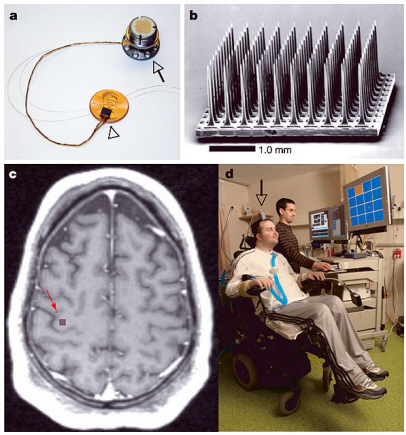25-year-old quadriplegic Matthew Nagel has become the first recipient of a brain implant designed to control the movements of a prosthetic limb.
Nagel, who sustained a knife injury that severed his spinal cord in 2001, has been working with neuroscientist John Donoghue of Brown University in Providence, Rhode Island, and his team, to develop the device. He is now the first participant in a clinical trial using the BrainGate Neural Interface system.
The BrainGate system is a neuromotor prosthetic device consisting of an array of one hundred silicon microelectrodes, each of which is 1mm long and thinner than a human hair. The electrodes are arranged less than half a millimetre apart on the array, which is attached to a 13cm-long cable ribbon cable connecting it to a computer.
The device, which has been implanted in Nagel’s motor cortex, detects electrical activity that is associated with the planning of movements, and transmits them to a series of computers. The signals are translated by the computers, which then produce an output that controls the movements of the prosthesis, and also of a cursor on a computer screen.
After just a few minutes of training, Nagel was able to use the device to send email, draw a simple figure using paint software, play a computer game and to use a multi-jointed robotic prosthetic arm to grasp and move an object, just by thinking about the movements necessary to do so.
In these initial trials, Nagel had a very limited control over the movements of the cursor and prosthetic arm. This may be because the device senses and transmits signals from only several dozen cells. With advances in technology, arrays containing larger numbers of smaller electrodes could sense the activity from more cells, providing greater control over movement. Greater control may also be achieved as the patient adapts to the device over time. The BrainGate also system requires a bulky set of apparatus and a trained technician for its operation. A wireless, miniaturized version of the device would be far more practical.
Donahue is head of research at Cyberkinetics Neurotechnology Systems Inc. in Foxborough, Massachusetts, which is developing the BrainGate system. He eventually hopes that the device can be developed for electrical stimulation of the limbs, allowing for the control of movement of patients’ own limbs; this is an alternative to coaxing severed nerve fibres to regenerate. If achieved, such a neuroprosthetic would improve the quality of life for the hundreds of thousands of people around the world who suffer from paralysis due to spinal cord injuries or disorders such as muscular dystrophy and motor neuron disease.
The current work is the result of decades of research in neuroscience, engineering, computing and electronics. It also draws heavily on experimental work done on monkeys. Neuroprosthetics is, however, still a new field; the devices are very crude, and much remains to be done, so many years may pass before they can be put to clinical use.
The results of the study are published in today’s issue of Nature.
Related posts:


Pingback: WIT » ไซบอร์ก ใครบอก ไซ-ไฟ
Pingback: World of Science News : Blog Archive : ESOF2008: Brain-computer-interfaces [Neurophilosophy]
Pingback: 改变人类的赛博格技术 « NHK纪录片精选
Pingback: almost daniel » universal by design